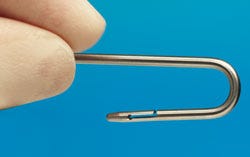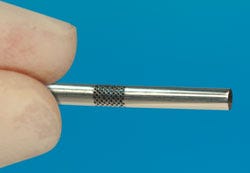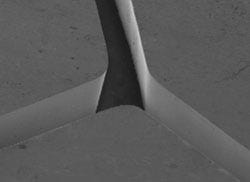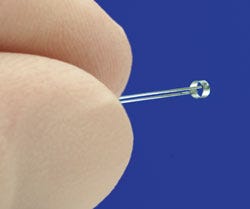As the application of lasers in medical device manufacturing has grown, the types and capability of lasers have also expanded. This growth in choice has made the selection of the optimum laser more complex, especially for those who don’t follow the rapid innovation in the laser field, but nonetheless need laser options in manufacturing.
During the Minnesota winter of 1957-58, in a garage workshop, the first wearable transistorized cardiac pacemaker was invented by Earl Bakken. Made at the request of world-renowned heart surgeon Dr. C. Walton Lillehei of the University of Minnesota, this invention kicked off a global industry manufacturing implantable, life-saving devices that revolutionized medicine.
|
Multiaxis laser systems cut, drill, and weld the complex features of pacemakers and other medical devices. |
In the early days of medical device manufacturing, proper device function and biocompatibility were major problems. The capability of a prosthesis implanted in a body to function properly and exist in harmony with tissue without causing deleterious changes was a constant challenge.
The industrial laser had not yet been invented. Bakken and his design team had to struggle to produce the components they needed with the conventional materials and machine tools of the day.
However, since the mid-1960s, lasers have been used to manufacture pacemaker components, carrying Bakken’s early designs to increasingly higher performance levels. Device function and biocompatibility have improved many times over, and the range of laser processed medical products has increased to produce a range of devices—stents, orthopedic devices, defibrillators, pacemakers, and sterile packaging—with high accuracy, efficiency and quality.
The objective of this article is to describe the main types of lasers used for materials processing (cutting, drilling and welding) in medical device manufacturing and to provide guidelines for helping to identify the correct laser for a medical device application.
It is important to remember that the laser source is only one component of a successful laser system, analogous to the engine of an automobile. Evaluation of laser-based manufacturing equipment for medical applications must consider the laser and the other components such as the motion system, control, process sensors, and ancillary components in the context of the requirements of the process and finished product.
Common Lasers For Medical Manufacturing
Carbon Dioxide (CO2) Laser. The laser beam is produced by electrical excitation of a mixture of carbon dioxide, nitrogen, and helium gases. This laser type is one of the earliest used in manufacturing with its first documented industrial application in the cutting and welding of titanium in 1966. The wavelength of this laser is in the far infrared (IR) at 10.6 µm.
Nd:YAG Laser. The laser beam is produced by excitation of a neodymium doped YAG (yttrium aluminum garnet) crystal by one or more high intensity flashlamps, or diode lasers. The wavelength of this laser is in the near infrared at 1.06 µm. Nd:YAG lasers used for medical manufacturing are primarily pulse types, Continuous wave (CW) versions have largely been displaced by fiber lasers.
Fiber Laser. The laser beam is produced by excitation of Yb (ytterbium) doped optical fiber using diode lasers. Note that there are other dopants for optical fiber but Yb is the most cost effective for high power application in medical manufacturing. The wavelength of this laser is also in the near infrared at 1.07 µm. The output of fiber lasers can be both pulsed and continuous.
Ultrashort Pulse Length Laser: The name refers to a class of solid state pulsed laser sources having output pulse lengths of a few hundred picosecond (10-12 seconds; ps) to femtosecond (10-15 seconds; fs) pulse lengths. These lasers typically have a fundamental wavelength in the near IR at 1.06 µm. The fundamental frequency (inverse of wavelength) is often doubled, tripled, or even quadrupled to produce visible or UV wavelengths when there are advantages to processing with these shorter wavelengths or when there is the need to focus the laser beam to a diameter smaller than can be achieved using the fundamental wavelength. The common feature of this type of laser is the ability to produce a very high quality beam, with very short pulse lengths at high frequencies, typically in the hundreds of kHz up to MHz frequencies.
Throughout the article are reference to the different mechanisms of material processing arising from the wide range of pulsed output. Laser characteristics are presented in Table I. Generally, the processes change from heating to melting to vaporization as the duration of the pulses decrease and peak power increases. The following sections describe the three main processes in medical device manufacturing and and the pros and cons of each laser type for these processes.
Laser Characteristics |
Wavelength |
Beam Delivery |
Pulsed versus Continuous Wave (CW) |
Average Power |
Peak Power |
Pulse Energy |
Pulse Width (duration) |
|
Beam Quality |
Table I. Medical manufacturers should understand basic laser characteristics determine what they might need for each applications. |
|
Probe pictured has a precision laser cut slot feature. Hard metals such as stainless steel and titanium can be clean cut free of burrs using a CO2 laser. |
Cutting
Laser cutting occurs when a focused laser beam of sufficient intensity to melt the work piece material is absorbed at the surface of the work piece. For cutting with CW and modulated CO2 and fiber lasers and CW and pulsed Nd:YAG lasers (nanosecond pulses to CW), an assist gas is delivered coincident with, and normally coaxial to, the focused laser beam to provide mechanical energy. The gas assist can also create chemical energy (ferrous materials react with oxygen to create an exothermic reaction) to remove the laser-melted material from the back side of the component.
A process known as clean cutting is used with many materials and involves the use of an inert gas, such as nitrogen, argon,or helium, to create an edge that is unreacted and free from burrs and debris with a small heat-affected zone depending on the choice of laser parameters and cutting speed. Cutting speed depends on the laser parameters, the capability of the motion system, and the work piece geometry. With ultrashort ps- and fs-pulse length lasers, assist gas is not required because material is removed by vaporization or sublimation, sometimes referred to as cold ablation. Little heat is absorbed by the work piece as a result of the combination of low energy, short pulse duration, and high repetition rates. The result is a cut edge characterized by a small, almost unmeasurable heat-affected zone, no recast, and no burrs or splatter. For medical cutting applications, the pros and cons of the four main laser types are summarized in Table II.
Laser Type | Cutting Pros | Cutting Cons |
|---|---|---|
CO2 |
|
|
Nd:YAG |
|
|
Yb Fiber |
|
|
Ultrashort Pulse |
|
|
Table II. The pros and cons of laser sources for cutting applications. |
Drilling
|
Nd:YAG lasers provide flexibility and precision for drilling holes of any shape and at all angles to the part surface. Holes smaller in diameter than a human hair are obtainable with repeatable precision. |
Drilling generally refers to the process for creating relatively small diameter (<1.5 mm) holes that range from normal-to-the-surface to angles as shallow as 10° from the surface. An assist gas may be used in this application to remove debris from and improve the quality of the holes and to protect the focus optics from the drilling debris.
Percussion Drilling. In the percussion method, the laser beam is focused to a diameter approximately equal to the required hole diameter. The laser is focused onto the surface of the stationary material and a series of laser pulses is delivered to the material, each one removing material by melt expulsion, until a hole is created through the material. A method of continuous hole production, usually referred to as Drill-on-the-Fly (DoF), is an extension of percussion drilling in which a cylindrical component, such as tubing, is rotated at a controlled speed while single laser pulses are applied to a series of hole locations. On subsequent rotations of the part, additional pulses are delivered to each hole location until a row of holes is created. Percussion drilling and DoF make use of the ability to obtain energy per pulse (up to 30 J) at a pulse rate of tens of pulses per second. Each pulse melts a portion of the material to be removed creating a high pressure within the melt cavity, and leading to the molten material being expelled in the form of droplets. The size of the droplets depends on the specific laser parameters and material composition.
Trepan Drilling. In the trepan method, the laser beam is focused to a diameter that is smaller than the required hole diameter. The material is first pierced with a small pilot hole, usually in the center of the required hole diameter. A circular, orbiting motion is then applied, either to the laser beam or the component, to cut the hole to the required diameter.
Ablation. During ablation, a high frequency, ultrashort pulse length laser is used to progressively ablate material to form a blind or through hole (Photo Four). The laser focus diameter is generally small in relation to the hole diameter. The beam is usually delivered to the work piece by means of a scanner, which can be programmed to raster (scan from side to side in lines from top to bottom) the laser focus at relatively high speed across the material to form the required shape, or in a circular or helical pattern to create round holes. Material is removed in layers from a few nanometers per pulse to one micrometer per pulse until the required depth is reached or a through hole is formed. Assist gas is not usually required for this type of drilling. While this type of drilling can produce features at high speed, the low energy, high frequency nature of the laser pulses means that, in practice, this method is limited to thin materials or shallow ablation depths. Ultrashort pulse length lasers can be used to produce low (<10) aspect-ratio holes in metals up to 5 mm thick, but they are more commonly used for thinner materials for which the vaporized material is efficiently and cleanly expelled from the hole.
Trepan drilling gives a good compromise between quality (roundness, taper, heat affected zone) and throughput (few holes per second) in a wide range of materials and thicknesses. Using DoF and ablation, holes can be produced at rates of more than 100 holes per second. However, the actual rate depends on the depth, diameter, and quality requirements of the hole. Generally, because of their high beam quality and millisecond pulse rates, Nd:YAG lasers provide a good balance of throughput and precision in producing holes in medical device components.
For medical drilling applications, the pros and cons of the four main laser types are summarized in the Table III.
Laser Type | Drilling Pros | Drilling Cons |
|---|---|---|
CO2 |
|
|
Nd:YAG |
|
|
Yb Fiber |
|
|
Ultrashort Pulse |
Absence of burrs and refined surface quality. |
|
Table III. Comparing the four main laser types for drilling applications. |
|
Due to the ablation nature of the material removal, ultrashort pulse length lasers have unique capability to produce fine patterns of slots and holes with very fine finishes and no significant heat affected zone. |
Welding
Laser welding also makes use of the ability to concentrate energy from the laser of sufficient magnitude to melt the materials in the joint. Although there are applications for laser welding of plastics, this discussion will focus on the welding of metals. The key to a successful laser welding application is fixturing and joint preparation to ensure consistently good fit-up (minimal gaps) during welding.
Laser welding falls into two categories. In autogenous welding materials are fused together without the addition of extra materials. This form of laser welding requires the highest level of fixturing and joint preparation. Because no material is added, it is essential the materials to be welded remain in intimate contact during the welding process. Any separation of the materials can result in, at best, an unacceptable weld profile and, at worst, complete failure of the welded joint. (Photo Five)
The second category is additive welding. Extra material is added to the weld, usually in the form of metallic wire or powder. By adding extra material, the joint becomes more tolerant and acceptable welds may be produced from joints with less than perfect fit-up. The addition of wire or powder to the joint does, however, create extra control variables and careful consideration should be given before any choice of weld type is made.
Laser welding requires the use of an inert shield gas to prevent oxidation of the weld and the surrounding area. Depending on the materials to be welded and the joint configuration, a broad spectrum of shield gas delivery options can be implemented. At its most basic level this can take the form of a simple co-axial or off-axis nozzle to deliver a cloud of shield gas to the local area. In its most complex form, this can take the form of a complete inert, dry, oxygen free glove-box.
For medical device welding applications, the pros and cons of the four main laser types are summarized in the following Table IV.
Laser Type | Welding Pros | Welding Cons |
|---|---|---|
CO2 |
|
|
Nd:YAG |
|
|
Yb Fiber |
|
|
Ultrashort Pulse | NA. These lasers are seldom used for welding for which melting is required. As with most rules, there are exceptions. For example, ps-pulse length lasers have been shown effective for producing a weld at the interface of two overlapping sheets of glass. | |
Table IV. Laser pros and cons for welding applications. |
Selecting Lasers for Multiple Applications
|
Autogenous micro-welding of dissimilar components is possible using a fiber laser system. This process opens a new range of medical device design possibilities especially where miniaturization is required for implantable devices. |
This discussion has concentrated on four laser types: CO2, pulsed Nd:YAG, Yb fiber, and ultrashort pulse length, and three medical processing applications: cutting, drilling and welding.
It is clear from the various descriptions that two of the laser types, CO2 and Yb fiber are more or less equally capable of cutting and welding thin and thick materials for medical devices. Ultrashort pulse length lasers are best used for cutting and drilling thin materials for which there is a requirement for little or no heat affected zoneor post-processing of the finished part.
Likewise, pulsed Nd:YAG lasers are the only type capable of drilling high aspect ratio holes, although recent developments in high peak power fiber lasers could lead to this type of laser also being used for hole drilling.
Selecting a laser for a combination of cutting and welding is a relatively easy choice. Selecting a laser type for a combination of drilling and cutting, drilling and welding, or all three processes remains difficult, because the decision may result in a system that does not give a satisfactory solution to all the processing requirements.
As soon as the drilling of high aspect ratio holes becomes a requirement, the laser choice must be a pulsed Nd:YAG. The only consideration after that is “What else can I do with this laser?” Certainly a wide variety of cutting and trimming applications would be possible, albeit at lower speeds than could be achieved with the other laser types. There would also be some autogenous welding capability but welding with filler materials would be beyond the capabilities of the typical pulsed Nd:YAG drilling laser.
The high capital cost of ultrashort pulse length lasers tends to restrict the use to specialist ablation and drilling tasks where CO2, Nd:YAG or fiber lasers give unsatisfactory results.
Conclusion
The choice of laser source for medical manufacturing applications is a key consideration in specifying a laser system. Guidelines presented in this article can be used to identify the best type or, at least, create a list of questions for identifying the optimum laser source.
Acknowledgements
The authors wish to thank Chuck Ratermann, RPMC Lasers Inc. for his input on the application of ultrashort pulse length lasers.
+++++++++++++++++++++++
| Terry VanderWert is president, Prima Electro North America (Chicopee, MA) and president of Prima Power Laserdyne (Champlin, MN). He has more than 35 years of experience in materials processeing and was a founding member of Laserdyne. Vanderwert holds a master of metallurgy and materials science and bachelor of metallurgical engineering from the University of Minnesota. He is a registered professional engineer in Minnesota. |
| Peter G. Thompson is technical director of Prima Power Laserdyne. He has more than 35 years experience with international laser and aerospace industries including heading his own company specializing in industrial laser applications and training. Thompson has held senior process engineering positions with Lumonics Ltd, Lucas Aerospace, Ltd. and MTE Ltd. He holds engineering degrees in both mechanical and electrical engineering. |
About the Author(s)
You May Also Like









